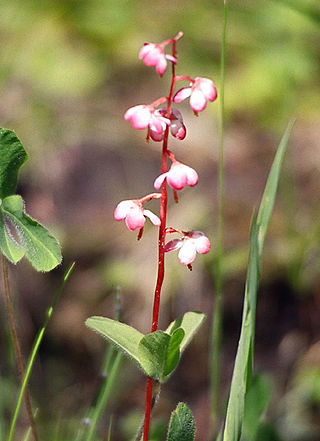
Pyrola is a genus of evergreen herbaceous plants in the family Ericaceae. Under the old Cronquist system it was placed in its own family Pyrolaceae, but genetic research showed it belonged in the family Ericaceae. The species are commonly known as wintergreen, a name shared with several other related and unrelated plants. They are native to northern temperate and Arctic regions.

Tripleurospermum inodorum, common names scentless false mayweed, scentless mayweed, scentless chamomile, and Baldr's brow, is the type species of Tripleurospermum. This plant is native to Eurasia and North Africa, and introduced to North America, where it is commonly found in fields, fallow land and gardens.

Layia platyglossa, commonly called coastal tidytips, is an annual wildflower of the family Asteraceae, native to western North America.

Pyrola asarifolia, commonly known as liverleaf wintergreen, bog wintergreen or pink wintergreen, is a plant species of the genus Pyrola native to western North America. It is found primarily on forest margins at mid latitude in the Pacific Northwest and northern California. It is so named simply because its leaves maintain their green color through winter.

Iris lacustris, the dwarf lake iris, is a plant species in the genus Iris, subgenus Limniris and in the section Lophiris. It is a rhizomatous, beardless perennial plant, native to the Great Lakes region of eastern North America. It has lavender blue or violet-blue flowers, a very short stem and long fan-like green leaves. It is cultivated as an ornamental plant in temperate regions. It is closely related to Iris cristata.

Platystemon is a monotypic genus of flowering plants in the poppy family containing the single species Platystemon californicus, which is known by the common name creamcups. It is native to Oregon, California, Arizona, Utah and Baja California, and is found in open grasslands and sandy soils below 6,000 feet (1,800 m) elevation.

Erythronium americanum, the trout lily, yellow trout lily, fawn lily, yellow adder's-tongue, or yellow dogtooth violet, is a species of perennial, colony forming, spring ephemeral flower native to North America and dwelling in woodland habitats. Within its range it is a very common and widespread species, especially in eastern North America. The common name "trout lily" refers to the appearance of its gray-green leaves mottled with brown or gray, which allegedly resemble the coloring of brook trout.

Lonicera sempervirens is a flowering plant species of honeysuckle vine native to the eastern United States which is known for its reddish flowers.
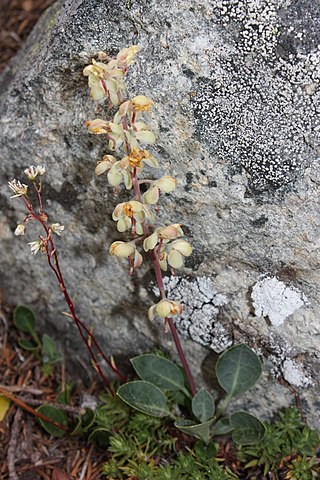
Pyrola picta, commonly called whiteveined wintergreen or whitevein shinleaf, is a perennial herb in the heath family. It is native to western North America from southwestern Canada to the southwestern United States.

Scrophularia lanceolata is a species of flowering plant in the figwort family known by the common names lanceleaf figwort and American figwort. It is native to North America, where it is known from western and eastern Canada and much of the United States except for the southeastern quadrant. Past common names include Western figwort when the western US plants were grouped under the name Scrophularia occidentalis and the eastern US plants were called Scrophularia leporella with the common name hare figwort.
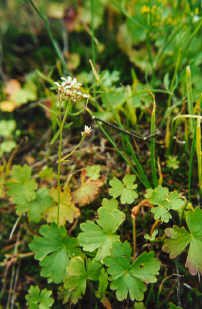
Hemieva ranunculifolia is a species of flowering plant in the saxifrage family known by the common name buttercup suksdorfia. It is the sole species in genus Hemieva. It is native to western North America from British Columbia and Alberta south to northern California. It grows in moist, rocky habitat in mountains and foothills. It is a non-rhizomatous perennial herb growing up to 40 centimeters tall. The leaves have rounded blades up to 4 centimeters wide with several large lobes edged with rounded teeth. The blades are light green, slightly fleshy, hairless in texture, and are borne on petioles up to 15 centimeters long. The inflorescence is a dense, flat-topped cluster of up to 35 flowers borne atop a mostly naked, hairy, glandular stalk. Each flower has a bell-shaped calyx of pointed sepals and five white or pink-tipped petals. The fruit is an oval brown capsule measuring 4 millimeters in length.

Thalictrum fendleri is a species of flowering plant in the buttercup family known by the common name Fendler's meadow-rue. It is named in honor of Augustus Fendler.

Thalictrum occidentale is a species of flowering plant in the buttercup family known by the common name western meadow-rue. It is native to northwestern North America from Alaska and western Canada to northern California to Wyoming and Colorado, where it grows in shady habitat types such as forest understory and more open, moist habitat such as meadows.

Trautvetteria caroliniensis is a species of flowering plant in the family Ranunculaceae native to North America. It is known by the common names Carolina bugbane, false bugbane, and tassel-rue. The genus is named for the botanist Ernst Rudolf von Trautvetter.
Agave phillipsiana is a rare species of flowering plant in the asparagus family known by the common names Grand Canyon century plant and Phillips agave. It is endemic to Arizona in the United States, where it lives only in Grand Canyon National Park. It is a perennial herb or shrub.

Allium fibrillum is a North American species of wild onion known by the common names Blue Mountain onion and Cuddy Mountain onion. It is native to the northwestern United States from eastern Washington and Oregon through Idaho to Montana. It is a perennial herb.

Cypripedium passerinum is a species of lady's slipper orchid known by the common names sparrow's-egg lady's-slipper, spotted lady's-slipper, and Franklin's lady's-slipper.
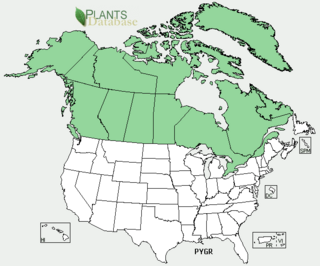
Pyrola grandiflora (, commonly known as Arctic wintergreen or largeflowered wintergreen, is a hardy perennial evergreen subshrub in the family Ericaceae. It is widely distributed in the Northern Hemisphere from temperate to tundra-like climates.
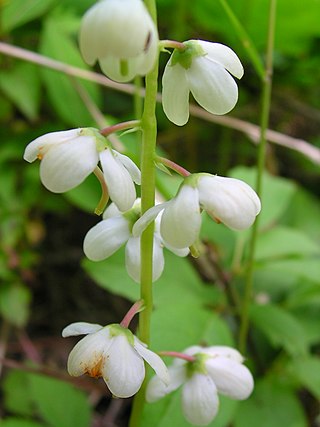
Pyrola elliptica, known as shinleaf, shinleaf pyrola, waxflower shinleaf, elliptic shineleaf and white wintergreen is a species of heath.

Hackelia deflexa is a vascular flowering plant in the borage family known by the common names, northern stickseed, nodding stickseed, and American stickseed





















